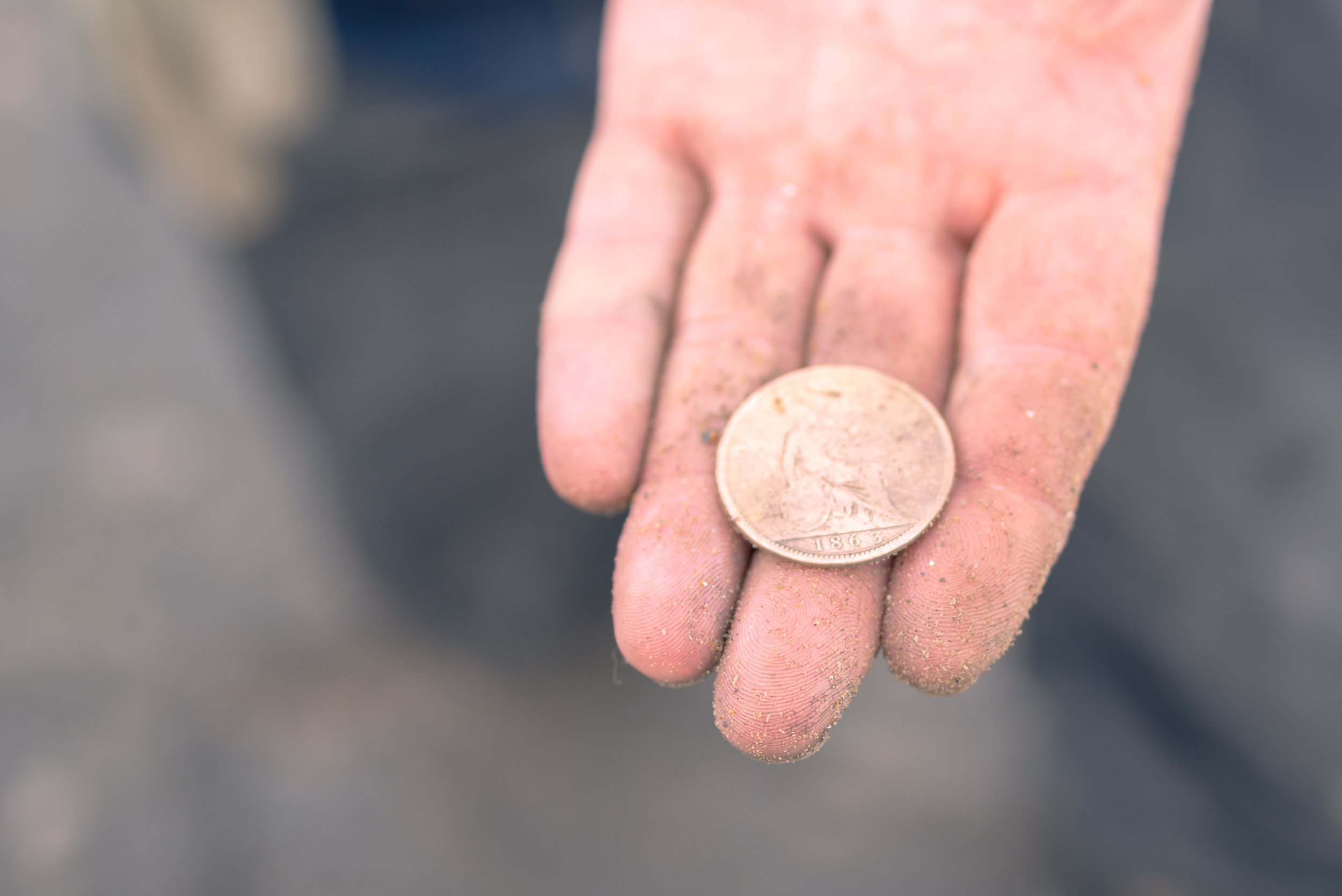Blog
The Detectorists
A chance encounter with some Detectorists on Redcar Beach.
Detectorists on Redcar beach search for older metallic objects.
Something that I view as one of the most beneficial aspects that I have gained by taking up photography is renewed curiosity. That is not to say that I wasn’t curious about things before I held a camera, it just seems that having the camera gives me an excuse, and the confidence, to speak to people that I otherwise might not. Steve McCurry talked about the camera being his passport, perhaps an excuse to travel, which seems similar to me using it as excuse to be nosey.
The day was pretty cold with a fairly clear sky when I visited Redcar Beach. Whilst the town might have lost some of the allure of its heyday, the beach has always been particularly stunning. The tide was low and had managed to strip away a lot of the sand from the beach leaving rocks exposed.
Redcar beach after the tide had stripped away much of the sand which usually covers the rocks.
The Dectorists were away in the distance when I first spotted them. Observing from a distance, I saw the methodical way in which they were working. With the main detector sweeping the ground, they would often pause to excavate the area that had triggered a reading. The digging was done using a unique looking shovel that looked like a steel net. The excavated sand was then emptied onto the rock, before being scanned again. If there was still a reading below the excavated area, a more precise inspection was carried out.
A finer inspection using a more precise bit of kit to identify the source of the metallic reading.
I made sure it was ok to start photographing them whilst they worked. In my head I was thinking they might not want a record of what part of the beach they were working on, for the same reason some photographers are protective of locations, so that it doesn’t become over visited. Taking advantage whilst they had a break, I wanted to find out a little more about the process.
A break in the search for treasure.
The Detectorists explained that due to the tidal conditions stripping away the sand, today was a particularly good day to be out. They explained that the range of the detectors was limited, and that with the layer of sand out of the way there was a greater chance of finding older coins and items. The heavier metals and older items tended to be buried further below the surface of the beach. Whilst finding ancient items from as far back as when Romans patrolled the coast was a possibility, they explained it would be unlikely this close to the shore. Due to the erosion of the coastline, Roman items would likely be further out, requiring a particularly low tide and fast work to locate anything.
Emptying out their finds for the day so far, there were the expected fishing weights and coins, but also a number of lead toy soldiers from Victorian times. The soldiers were all found in the same place and it is impossible not to think of a child playing with them on the beach before carelessly leaving them behind all those years ago. One wonders whether the child got into trouble when their parents found out!
Should anything of value be found, the Detectorists are legally required to report their find under the Treasure Act 1996. In general, anything over 300 years old was taken to Kirkleatham Museum so that it could be sent away for identification, logged, and the location it was found recorded. The item would then be returned to the finder. This process of cataloguing finds is handled by The Portable Antiquities Scheme .
The process of sweeping the beach without any guarantee of finding anything struck me as very similar to going out with a camera. We always hope we are going to get something worth keeping, but there are no guarantees. You just have to enjoy the process rather than just the end result.
Sheep Shearing.
A short photo essay documenting a day shearing sheep in rural North Yorkshire.
How are sheep sheared?
If you have found yourself asking that question, you have come to the right place! Well visually at least.
Whilst no doubt stressful for the animals, shearing is required for the welfare of the animal, in the case of most breeds, as sheep do not shed their wool in the warmer months. In order to make the process as quick and efficient as possible, the sheep are herded up the gangway to the trailer before the panels are dropped. The sheep are then rolled onto their backs to reduce mobility and the chance of injury allowing the fleece to be removed in a matter of seconds. The work is physically demanding and highly skilled which requires years of practice by those involved.
What is British Wool used for?
According to the body that oversees the collection and sale of the majority of UK wool (https://www.britishwool.org.uk/), it is used for;
Carpets
Beds and bedding
Fashion
Insulation
Interiors ‘ textiles
Crafts
(https://www.britishwool.org.uk/what-do-we-use-wool-for)
Is British Wool Valuable?
You would be surprised to learn that the price a farmer gets for their fleeces, often does not cover the cost of shearing. During the pandemic the average price per kilo crashed to £0.32 (https://www.theguardian.com/environment/2022/may/26/shear-desperation-low-price-of-wool-pushes-farmers-to-opt-for-moulting-sheep). Whilst The British Wool Board announced an increase of around 135% on payments for 2021 (https://www.farminguk.com/news/british-wool-announces-135-increase-in-payments-for-2021-clip_60395.html), the estimated average cost to shear one animal is £1.65 (https://www.theguardian.com/environment/2022/may/26/shear-desperation-low-price-of-wool-pushes-farmers-to-opt-for-moulting-sheep).
This sequence is part of a wider body of work centre around my immediate area. Having documented the villages’ inaugural scarecrow competition and jubilee celebration, it is my hope to build up an archive of things that will no doubt change over the next few years.





















